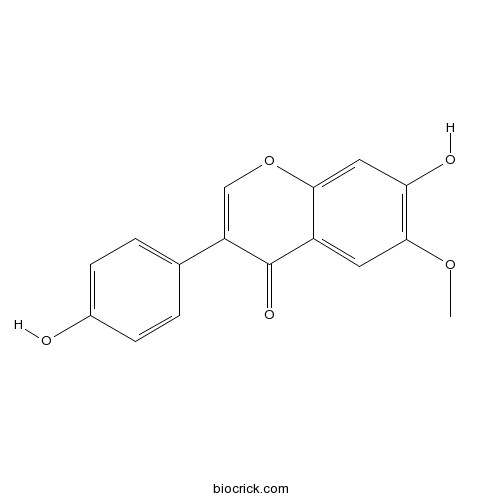Maackia amurensis
Maackia amurensis
1. The products in our compound library are selected from thousands of unique natural products; 2. It has the characteristics of diverse structure, diverse sources and wide coverage of activities; 3. Provide information on the activity of products from major journals, patents and research reports around the world, providing theoretical direction and research basis for further research and screening; 4. Free combination according to the type, source, target and disease of natural product; 5. The compound powder is placed in a covered tube and then discharged into a 10 x 10 cryostat; 6. Transport in ice pack or dry ice pack. Please store it at -20 °C as soon as possible after receiving the product, and use it as soon as possible after opening.
Natural products/compounds from Maackia amurensis
- Cat.No. Product Name CAS Number COA
-
BCN1236
Maackiain19908-48-6
Instructions

-
BCN5895
Glycitin40246-10-4
Instructions

-
BCN5896
Glycitein40957-83-3
Instructions

Lotus tetragonolobus, Ulex europaeus, Maackia amurensis, and Arachis hypogaea (peanut) lectins influence the binding of Helicobacter pylori to gastric carbohydrates.[Pubmed: 29790696]
The carbohydrates of gastric mucins and other sugar structures are involved in interactions with Helicobacter pylori (H. pylori) adhesins. The binding of bacteria to mucins can protect the epithelium from direct contact with the pathogen and from developing infection because of a specific barrier created by the mucus. The pathogen also interacts with other carbohydrate structures of the epithelium. Direct contact between the bacteria and the epithelial cells facilitates infection development.
The effect of plant lectins on the survival and malignant behaviors of thyroid cancer cells.[Pubmed: 29663501]
Altered or aberrant glycosylation is a common phenomenon in cancer cells and it originates from changes in the expression of the enzymes, glycosyltransferase, and glycosidase which up-regulate in response to some oncogenes in the glycan synthesis pathway. In this present study, it has been aimed to determine the alteration of sialic acid and fucose expressions in the cell surface of human thyroid carcinoma cells and investigate the changes in tumorigenic and malignant characters after treating them with specific plant lectins. Our study showed that the cell surface glycan chains of anaplastic 8305C, follicular FTC-133, and papillary K1 thyroid carcinoma cells were rich in α-2,6, α-2,3, sialic acid, and α-1,6 fucose residues. When the cells were treated with specific doses of Maackia amurensis lectin II (MAL), Sambucus nigra agglutinin (SNA), and Aleuria aurantia lectin (AAL) which have specific binding capacity for the detected glycan residues, respectively their cancerous traits changed dramatically. Remarkable findings obtained from MAL treatment leading to necrosis in 8505C cells without any toxicity for normal thyroid epithelial cells but it had proliferative effect on K1 and FCT-133 cells. Besides, MAL and SNA treatment decreased the mobility of 8505C and K1 cells. MAL and SNA lectins dramatically reduced the endothelial affinity of the cells and AAL significantly attenuated that of 8050C and K1 cells but not FTC-133. These results suggest that altered cell surface glycosylation in thyroid cancer seems to be a strong candidate for developing new therapeutic strategies.
Allometric biomass equations for 12 tree species in coniferous and broadleaved mixed forests, Northeastern China.[Pubmed: 29351291]
Understanding forest carbon budget and dynamics for sustainable resource management and ecosystem functions requires quantification of above- and below-ground biomass at individual tree species and stand levels. In this study, a total of 122 trees (9-12 per species) were destructively sampled to determine above- and below-ground biomass of 12 tree species (Acer mandshuricum, Acer mono, Betula platyphylla, Carpinus cordata, Fraxinus mandshurica, Juglans mandshurica, Maackia amurensis, P. koraiensis, Populus ussuriensis, Quercus mongolica, Tilia amurensis and Ulmus japonica) in coniferous and broadleaved mixed forests of Northeastern China, an area of the largest natural forest in the country. Biomass allocation was examined and biomass models were developed using diameter as independent variable for individual tree species and all species combined. The results showed that the largest biomass allocation of all species combined was on stems (57.1%), followed by coarse root (21.3%), branch (18.7%), and foliage (2.9%). The log-transformed model was statistically significant for all biomass components, although predicting power was higher for species-specific models than for all species combined, general biomass models, and higher for stems, roots, above-ground biomass, and total tree biomass than for branch and foliage biomass. These findings supplement the previous studies on this forest type by additional sample trees, species and locations, and support biomass research on forest carbon budget and dynamics by management activities such as thinning and harvesting in the northeastern part of China.
Lotus tetragonolobus and Maackia amurensis lectins influence phospho-IκBα, IL-8, Lewis b and H type 1 glycoforms levels in H. pylori infected CRL-1739 gastric cancer cells.[Pubmed: 29197783]
Attachment of Helicobacter pylori to the mucous epithelial cells and the mucous layer is said to be a crucial step for infection development. Sugar antigens of gastric mucins (MUC5AC, MUC1) can act as receptors for bacterial adhesins. The aim of the study was to investigate if Lotus tetragonolobus and Maackia amurensis lectins influence the level of MUC1, MUC5AC, Lewis b, H type 1, sialyl Lewis x, phospho-IκBα and interleukin 8 in Helicobacter pylori infected gastric cancer cells.
Label-free chronopotentiometric glycoprofiling of prostate specific antigen using sialic acid recognizing lectins.[Pubmed: 28651174]
In recent decades, it has become clear that most of human proteins are glycosylated and that protein glycosylation plays an important role in health and diseases. At present, simple, fast and inexpensive methods are sought for clinical applications and particularly for improved diagnostics of various diseases, including cancer. We propose a label- and reagent-free electrochemical method based on chronopotentiometric stripping (CPS) analysis and a hanging mercury drop electrode for the detection of interaction of sialylated protein biomarker a prostate specific antigen (PSA) with two important lectins: Sambucus nigra agglutinin (SNA) and Maackia amurensis agglutinin (MAA). Incubation of PSA-modified electrode with specific SNA lectin resulted in an increase of CPS peak H of the complex as compared to this peak of individual PSA. By adjusting polarization current and temperature, PSA-MAA interaction can be either eliminated or distinguished from the more abundant PSA-SNA complex. CPS data were in a good agreement with the data obtained by complementary methods, namely surface plasmon resonance and fluorescent lectin microarray. It can be anticipated that CPS will find application in glycomics and proteomics.


